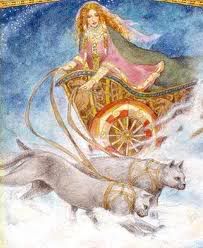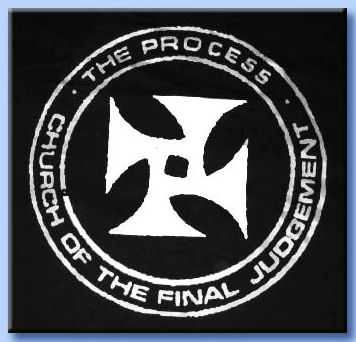In the last five years or so, our Earth has been making some bizarre noises, usually from under the ground. These occurrences come in many forms, and you can find them on YouTube. The sky is the limit as far as how different people and concerns can interpret what this is or why it's happening. However, the occurrence in the above video from a city in rural British Columbia takes the cake! It sounds like a massive trumpet or horn. If I allow my imagination to go free, I almost imagine something out've Odinic mythology, and the thunder-like grumbling made Thor come to mind. Perhaps the trumpets at the Battle of Legnano. Also, the trees rustling in the wind, especially after the sounds are over, remind me of the spirit of the Almother. Something tells me that this whole phenomenon has something to do with the "electric universe." Like with so many other subjects, modern science rejects the electric universe because then they would have to say "oh, all of the things we have proven in the past, well, they're all false," which wouldn't work well for scientific/academic "careerists."
Pagan calendar website
This Pagan calendar shows Pagan, Witch, Druid and Heathen festivals, dates and events.
This site is from the UK, and doesn't include southern or eastern European traditions, but there's so much overlap. Good daily rundown, with moon cycles. I think pagans should develop their own traditions and important dates to merge into this concept.
"The Process Church"
I watch a lot of YouTube videos, but usually the subjects aren't applicable here. However, if you wanted to watch something very macob but still interesting, there are quite a few videos about the Satanic "Process Church." They were involved in many bizarre happenings. This, of course, has nothing to do with "native-folk spirituality." Many Satanists say that they're actually Atheists who worship the self in some manner. There are also many who worship the Satan of the Christian Bible. I have no doubt that the Process Church is still around. Their philosophers are pretty dark, as opposed to--for example--the Temple of Set, which I believe tries to avoid a negative image for the most part. Also, many of the webpages or articles devoted to the Process Church are pretty dark in nature.
Since I mentioned Mt. Shasta in part one, I found the main documentary. Although this generally goes beyond what this blog covers, the metaphysical power of mountains does tie in to the folk-spirit concept. Many times the works of researchers like Jordan Maxwell, Michael Tsarion, Mark Passio, Jay Wiedner, or David Wilcock do overlap.
"Polytheists calling "Pagan" a negative term?
Two recent posts by the AFA present this term negatively. One, entitled 'A Declaration from the European Council of Ethnic Religions', quoted the council's declaration: "We object to the use of the term “pagan” by extremist political groups of any kind, as it reflects negatively on our reputation." This may be partly true, but doesn't the term "religious" also give a false perception in the minds of most people? I think I would rather be called a "pagan," than to be called "religious."
The other post was entitled 'The Difference Between Asatru and Modern "Paganism."' The post, which was only one paragraph, stated: Asatru has much more in common with traditional American Indian religion, indigenous African religion, or similar ethnic beliefs than with what passes for "paganism" in the modern industrialized West. It is the “way of a people” - in our case, the people of Northern Europe. It is a part of our deeper identification, our way of relating to the Holy, an expression of the soul of our Folk. We have been cut off from these root for too long...but every day, our sense of reconnection grows!
I think there is a need for more clarity here. For one thing, Asatru/Odinism--during the late the pre-Christian era-- was dominant in what is today Norway, Sweden, Denmark, Holland, Germany, Switzerland, Austria, and what had been Prussia. This wouldn't include Finland, which had a different indigenous spiritual tradition and pantheon of gods. Still, that's a large territory. However, it wasn't the only tradition of northern Europe! The reason I think this is applicable here is that this "modern paganism," is at least partly derived from traditions of Europe... including those which co-existed in what were these Odinic regions. Therefore, in those cases, how could Asatru be closer to native spiritual traditions on other continents?
I understand, the AFA is making reference to some of the eclectic, rootless, and generally jackassy behavior of some Wiccans and Pagans. However, there's sometimes a thin line between some of that behavior and what really was a tradition of very spirited ceremonies... such as parades with animal and other masks. For example, ancient Gaul (today France) was not Odinic! Certainly there was a lot of crossover, Odinic influence touched every part of Europe at some point, and it may have been the primary pre-Christian tradition of northern-central Europe. The Druids, at one point, were present in what is today the British Isles, France, and parts of Germany; as well as perhaps Scandinavia, Spain, and elsewhere. That is also a large territory.
This declaration by the European Council of Ethnic Religions umbrella organization is a good thing. It addresses many of the problems of these native spiritual folk societies. Interestingly, among these societies three were from Italy: Societas Hesperiana (Greek pantheon in Italy), Movimento Tradizionale Romano (Roman pantheon), and Federazione Pagana Italiana (Celtic and Streghe traditions). It's interesting that the Roman groups used the phrase "Saturnia Tellus," which means something like "the land of Saturn"... as the peninsula was once known as "Saturnia." These aren't the only groups in Italy. Comunità Odinista (Langobard/Odinist) and Ordine Bardi, Ovati e Druidi (Gaulish/Druidic) come to mind. Comunità Odinista is a worldwide group for Odinic-Langobard descendants, and Ordine Bardi, Ovati, e Druidi is the Italian branch of a worldwide group called The Order of Bards, Ovates, and Druids. It's important to remember that, although this all sounds so organized, these are very small groups.
The "Llullaillaco Maiden" was a fifteen year old Amerindian girl who was sacrificed five-hundred years ago, and was discovered frozen inside of an inactive Argentine volcano at 22,000 feet. After being thawed out, she was put in a museum in Argentina, and she looks as though she could wake up, stand, and walk away as seen here.
 A website all about the Norse/Langobard Goddess Freya:
A website all about the Norse/Langobard Goddess Freya:GoddessFreya.info
There is a lot of interesting information and folklore about Freya here. Some of the images are great; some too overtly sexualized. I especially like the prayers and invocations.
Reality star lives like an ancient Celt
Mick Dodge seems to be a modern-day "ancient Celt." He looks like, has the survival skills of, and lives in harmony with the land like.. a Celt.
Watch: Mick and Will build a forest roundhouse, an ancient structure that the Celts inhabited thousands of years ago.
Brescian Stiletto C. 1600 for sale by Fagan Arms
Brescia, Italy has been noted for the quality of its metal work since the early Renaissance. Pierced, embossed and relief chiseled elements for furniture, swords, daggers, armor and later, firearms of the finest quality were produced. This stilleto is a product of a Brescian workshop of the late Renaissance. Its deeply chiseled hilt is adorned with lovely scrolling Spring tendrils with heart shaped leaves in ironic, a doubly ironic contrast to its sole function: to end life. The scalloped edge diamond section blade is made to penetrate protective clothing and the scallops may have been intended to facilitate the introduction of poison or and infectant into the wound. Blade length: 6 7/16"
Price: $2,800
I would love to own that. There are some good and very affordable replicas at BudK.
.









